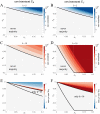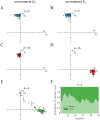Minor variations in multicellular life cycles have major effects on adaptation
- PMID: 37083675
- PMCID: PMC10156057
- DOI: 10.1371/journal.pcbi.1010698
Minor variations in multicellular life cycles have major effects on adaptation
Abstract
Multicellularity has evolved several independent times over the past hundreds of millions of years and given rise to a wide diversity of complex life. Recent studies have found that large differences in the fundamental structure of early multicellular life cycles can affect fitness and influence multicellular adaptation. Yet, there is an underlying assumption that at some scale or categorization multicellular life cycles are similar in terms of their adaptive potential. Here, we consider this possibility by exploring adaptation in a class of simple multicellular life cycles of filamentous organisms that only differ in one respect, how many daughter filaments are produced. We use mathematical models and evolutionary simulations to show that despite the similarities, qualitatively different mutations fix. In particular, we find that mutations with a tradeoff between cell growth and group survival, i.e. "selfish" or "altruistic" traits, spread differently. Specifically, altruistic mutations more readily spread in life cycles that produce few daughters while in life cycles producing many daughters either type of mutation can spread depending on the environment. Our results show that subtle changes in multicellular life cycles can fundamentally alter adaptation.
Copyright: © 2023 Isaksson et al. This is an open access article distributed under the terms of the Creative Commons Attribution License, which permits unrestricted use, distribution, and reproduction in any medium, provided the original author and source are credited.
Conflict of interest statement
We the authors declare no competing interests.
Figures






Similar articles
-
Adaptive evolutionary trajectories in complexity: Transitions between unicellularity and facultative differentiated multicellularity.Proc Natl Acad Sci U S A. 2025 Jan 28;122(4):e2411692122. doi: 10.1073/pnas.2411692122. Epub 2025 Jan 22. Proc Natl Acad Sci U S A. 2025. PMID: 39841150 Free PMC article.
-
The Consequences of Budding versus Binary Fission on Adaptation and Aging in Primitive Multicellularity.Genes (Basel). 2021 Apr 28;12(5):661. doi: 10.3390/genes12050661. Genes (Basel). 2021. PMID: 33924996 Free PMC article.
-
Alternating selection for dispersal and multicellularity favors regulated life cycles.Curr Biol. 2023 May 8;33(9):1809-1817.e3. doi: 10.1016/j.cub.2023.03.031. Epub 2023 Apr 4. Curr Biol. 2023. PMID: 37019107 Free PMC article.
-
Why have aggregative multicellular organisms stayed simple?Curr Genet. 2021 Dec;67(6):871-876. doi: 10.1007/s00294-021-01193-0. Epub 2021 Jun 10. Curr Genet. 2021. PMID: 34114051 Review.
-
Mosaic physiology from developmental noise: within-organism physiological diversity as an alternative to phenotypic plasticity and phenotypic flexibility.J Exp Biol. 2014 Jan 1;217(Pt 1):35-45. doi: 10.1242/jeb.089698. J Exp Biol. 2014. PMID: 24353202 Review.
Cited by
-
Adaptive evolutionary trajectories in complexity: Transitions between unicellularity and facultative differentiated multicellularity.Proc Natl Acad Sci U S A. 2025 Jan 28;122(4):e2411692122. doi: 10.1073/pnas.2411692122. Epub 2025 Jan 22. Proc Natl Acad Sci U S A. 2025. PMID: 39841150 Free PMC article.
References
-
- Schopf JW, Haugh BN, Molnar RE, Satterthwait DF. On the development of metaphytes and metazoans. Journal of Paleontology. 1973; p. 1–9.
-
- Smith JM, Szathmary E. The major transitions in evolution. Oxford University Press; 1997.
Publication types
MeSH terms
LinkOut - more resources
Full Text Sources
Miscellaneous

